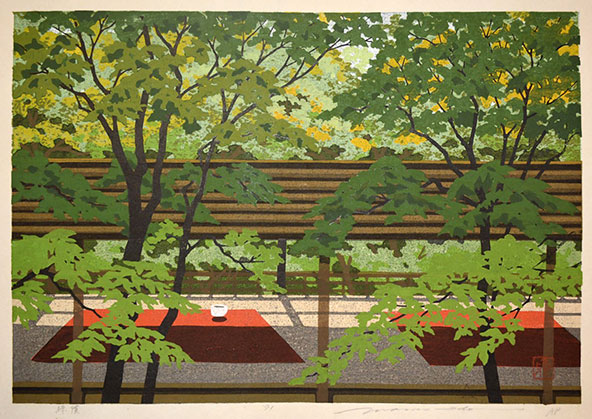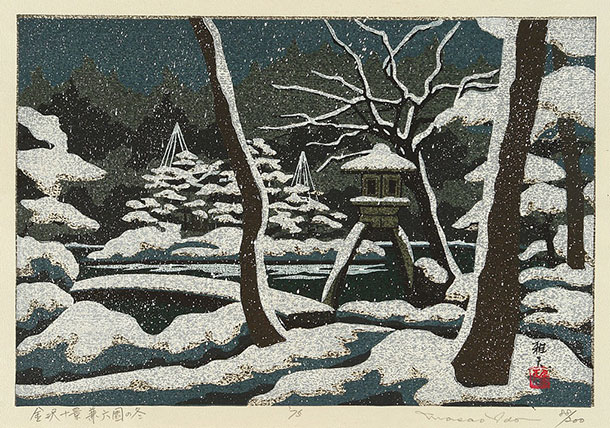

IDÔ Masao (井堂雅夫)
|
Idô Masao (井堂雅夫) was born in an air-raid shelter in Beipiao, Chaoyang prefecture, Liaoning province (northeast China) in 1945. The following year his family moved first to Kyoto, his parent's home city, and soon after to Iwate. He began drawing and painting while in grade school, but in 1959, when he was fourteen, his parents separated and he moved back to Kyoto. Eventually, through his grandfather's connections, Idô was introduced in 1961 to Mitsuho Yoshida, a traditional fabric dyer, for whom he he served as a live-in apprentice, first as a menial assistant but later as a serious student. He also studied in Kyoto with the textile-dyeing artist Yoshida Kôhô.
 |
| Idô Masao: Ryokuin (Green shade: 緑蔭), 1991 Woodcut; image: 330 x 445 mm; |
Idô once described his path toward printmaking: "While continuing to dye fabric for kimono and obi (帯) sashes for a living, in my spare time I began to create my own artworks and submit them to various exhibitions. A little later, a printmaking friend introduced me to an art dealer, and I was offered an opportunity to hold my first solo exhibition at his gallery. I made drawings with dye-inks and wax on hand-made paper, and called them 'batik'. I was twenty-five then, and it marked an important first step as an artist. I can't forget the thrill of selling my first work. Soon, when I was beginning to feel a strong urge to create something other than dyeing works, the art dealer showed me woodblock prints by Saitô Kiyoshi. The moment I saw them, I got my answer. I was so deeply inspired by his works that I immediately started to study the world of woodblock printmaking. I visited carvers' and printers' workshops whenever I found time to see a variety of wonderful techniques and understand the long history of printmaking. I was completely drawn into this world."
Idô considered becoming an eshi (painter or designer: 絵師) in the manner of Edo-period ukiyo-e production, engaging exclusively in drawing the original pictures for prints. He said that artists should "create something new from scratch, while the artisan's job is to realize the artist's ideas in actual works by employing their advanced skills." However, the number of highly skilled artisans was rapidly decreasing, so he "decided to create a hanmoto (in this case, a publisher in ukiyo-e tradition: 板元).... I asked carvers and printers to teach young people their techniques systematically. At the same time, I thought of owning a gallery which would exclusively show woodblock prints. In order to realize such a dream, I continued to produce kimono and obi during the day in my dyeing studio as my source of income, employing about ten workers, and made sketches for prints at night. Finally, in 1982, I opened a gallery [Gallery Gado, ギャラリー雅堂 in Kyoto] which would serve as a center for printmaking and its promotion."
 |
| Idô Masao: Kyô-kurama (京くらま), 1973 Woodcut; edition: 30; paper: 320 x 440 mm; image: 262 x 388 mm |
Idô's first woodcuts appeared in 1972, the same year he studied printmaking in Kyoto with the painter/designer Ôtsubo Shigechika (1899-1998), who was a graduate of the Tokyo Fine Arts School (Tokyo Bijutsu Gakkô, 東京美術学校 in 1921). At first, Idô's palette was restrained and occasionally nearly monochrome, featuring the use of a rich black pigment. An example, from 1973, is shown immediately above. Titled Kyô-kurama (京くらま), the intense black forms are enhanced by subtle washes of pale rose and violet in some of the unprinted (white) spaces. The scene depicts the dark compound of the Kurama-dera (鞍馬寺), a former Tendai-sect temple at the base of Mt. Kurama in northern Kyoto (in 1949 it established its own esoteric religious community). Legend has it that the Minamoto warrior Yoshitsune (源義経 1159-1189) received martial arts lessons from tengu (goblins of great strength and cunning: 天狗) within the temple grounds. Some people residing in the area today still claim to believe that tengu and other mountain spirits live in the surrounding wilderness.
Another early woodcut, this one in dark colors, is shown below. Titled Kenroku-en no fuyu ("Six-attributes garden in winter": 兼六園の冬), it is from the series Kanazawa jukkei (Ten scenes of Kanazawa: 金沢十景) published in 1975 in an edition of 200. A heavy snowfall blankets the garden. Kenroku-en, created by the feudal lords (daimyô) of Kaga in the current southern part of Ishikawa in Kanagawa was designed as a daimyô garden. Begun by the clan's fifth lord, Tsunanori Maeda (前田綱紀 1643-1724), the site is considered by many to be one of the three most beautiful gardens in Japan, in particular, possessing the six attributes of a perfect garden (spaciousness, seclusion, artifice, antiquity, elaborate use of water, and panorama or scenic charm). In the near-center of Idô's print is the iconic two-legged stone lantern called Kotoji tôrô (徽軫灯籠), which is said to resemble the bridge on a koto (Japanese horizontal harp: 琴). This lantern is emblematic of Kenroku-en and Kanazawa. Idô has captured most effectively the dark mood of a frigid day in the famous garden.
 |
| Idô Masao: Kenroku-en no fuyu (Kenroku Garden in winter: 兼六園の冬) Series: Kanazawa jukkei (Ten scenes of Kanazawa: 金沢十景) 1975 Woodcut; edition: 200; paper: 310 x 450 mm; image: 260 x 385 mm |
When Idô's printmaking matured, he developed a bright color palette that featured, among other things, a distinct shade of green and its variants that some admirers, he was once told, were fond of calling "Idô-Green." He explained it this way: "At one occasion, a non-Japanese called the green an 'Idô Green'. I instinctively create the colors on the palettes. I can't explain how to create it theoretically, although I'm very happy to hear that people call my green an 'Idô Green'." This is exemplified by the image shown at the top of this page. Titled Ryokuin (Green shade: 緑蔭), it was carved and printed in 1991. There appear to be at least six hues of the Idô Green, along with a nearly as distinctive orange-red.
The following design, called Kotoin sandô (Visiting path at Koto-in: 高桐院参道), was made in 1996. The Koto-in, a sub-temple of the Daitoku-ji (大徳寺) in northwest Kyoto, was established in 1601 by the samurai warrior Hosokawa Tadaoki (細川忠興 1563-1646) who was a disciple of the famed tea master Sen no Rikyû (千利休 1522-1591), considered the historical figure who had the most profound influence on Cha-no-yu ("Way of Tea": 茶の湯). The intensity of the fall foliage offers a brilliant interpretation of the temple's flagstone path, whose canopy of deciduous trees turn bright colors in autumn. Idô's typical granular texturing covers the entire design, a graphic technique that he seems to have adapted from Saitô Kiyoshi, whose influence can be found in many of Idô's works.
 |
| Idô Masao: Kotoin sandô (Visiting path at Koto-in: 高桐院参道), 1996 Woodcut; edition: 200; image: 525 x 320 mm |
Occasionally, Idô produced designs with dramatic skies at sunset. The most expressionistic of these is shown below. Titled Yûbae (Sunset glow: 夕映え) from 1997, it was issued in an edition of 250. Dare we suggest that the extraordinary blood-red sky evokes the famous expressionist artwork (first painted in 1893) by the Norwegian Edvard Munch (1863-1944) called "The Scream" or Skrik ("Shriek")? Regardless, this is decidedly an atypical print for Idô with overtones of Symbolism and Expressonism. While a few other sunset images by him use similar emphatic colors in the sky, none approach the emotional impact of this work.
_610w.jpg) |
| Idô Masao: Yûbae (Sunset glow: 夕映え), 1997 Woodcut; edition: 250; image: 193 x 300 mm; paper: 470 x 370 mm |
In 2008, from his studio in Kyoto, Idô completed the series Kyoto hyakkei (One hundred scenes of Kyoto: 京都百景), having spent five years on the project. The series is organized by ten subdivisions (a further ten designs were added later, bringing the grand total to 110). Idô considered the series a sort of Heisei-period ukiyo-e, saying, "The idea behind this project was that, even after my passing, printers will be able to reprint these hundred scenes using the blocks (there are about a thousand), and even when these blocks are worn out, carvers can re-carve the images on new blocks and continue to print them, since ukiyo-e has no edition numbers. In this way, I can continue to provide jobs for future carvers and printers while the techniques are being handed down. Thus, I can entrust my dream to future generations." The style is different from the other images shown on this page. There is a less-saturated use of color and more simplified drawing than is true for most of his other oeuvre. Overall, the series reminds one of certain modern Kyoto print artists such as Tokuriki Tomokichirô (徳力富吉郎 1902-2000). The example illustrated below is titled Togetsukyô ("Moon-crossing Bridge": 渡月橋), which is located in Arashiyama ("Storm Mountain": 嵐山), a district on the western outskirts of Kyoto. The Togetsukyô spans the Ôi-gawa (Ôi River: 大堰川) and is well-known as one subject among the Rokujûyoshû meisho zue (Famous views of the sixty-odd provinces: 六十余州名所図会) in ukiyo-e prints. Arashiyama is a nationally designated "Historic Site" and "Place of Scenic Beauty." Given that this is an unlimited-edition series, it has been printed, as intended, after his death, and thus is not signed in pencil; instead, Idô carved his artist seal in the block, which reads "Masa" (雅). The image below is shown uncropped to reveal the large margins that have so far appeared on impressions from this series.
_610w.jpg) |
| Idô Masao:Togestsukyô (Moon-crossing Bridge": 渡月橋), 2008 Series: Kyoto hyakkei (One hundred scenes of Kyoto: 京都百景) Woodcut; edition: unlimited; image: 193 x 300 mm; paper: 245 x 350 mm |
There is one other area of creative work that engaged Idô, namely, painting on fabrics, where he often used fast-drying acrylics as well as standard watercolors. He enjoyed the freedom of applying brush strokes to various media, which, he felt, released him from the demanding nature of designing prints to be made from carved blocks. He sometimes adapted the Japanese painting style called Rinpa (琳派,) and occasionally produced abstracts. He reported that his favorite method was acrylic painting on silks. Referred to as kenpon saishiki (color painting or calligraphy executed on textiles such as silk: 絹本彩色), an example from Idô's oeuvre is shown below. Titled Hishô (Flying: 飛翔), the work is a painted four-panel byôbu (folding floor screen: 屏風). The Rinpa manner is present here, harkening back to earlier periods and nativist mannerisms of depicting kachôga (bird and flower pictures: 花鳥画). Along with figure and landscape painting, such portrayals of the natural world represent a primary thematic grouping within classical Chinese and Japanese art.
 |
| Idô Masao:Hishô ("Flying": 飛翔), date unknown(?) Painting on fabric; image: 1,800 ×3,600 mm |
Prints by Idô Masao can be found in many private collections as well as in important public institutions, including the Honolulu Museum of Art; Los Angeles County Museum of Art; and Museum of Fine Arts, Boston. © 2020 by John Fiorillo
BIBLIOGRAPHY
- Idô, Masao: Official website (www.gado.jp/en/story.html).
- Idô, Masao: A Poem of Printing: The Woodblock Prints by Masao Idô. Kyoto Shoin Co, Ltd., 1998.
- Merritt, Helen, and Yamada, Nanako: Guide to Modern Japanese Woodblock Prints 1900-1975. Honolulu: University of Hawaii Press, 1992, p. 38.
Viewing Japanese Prints |